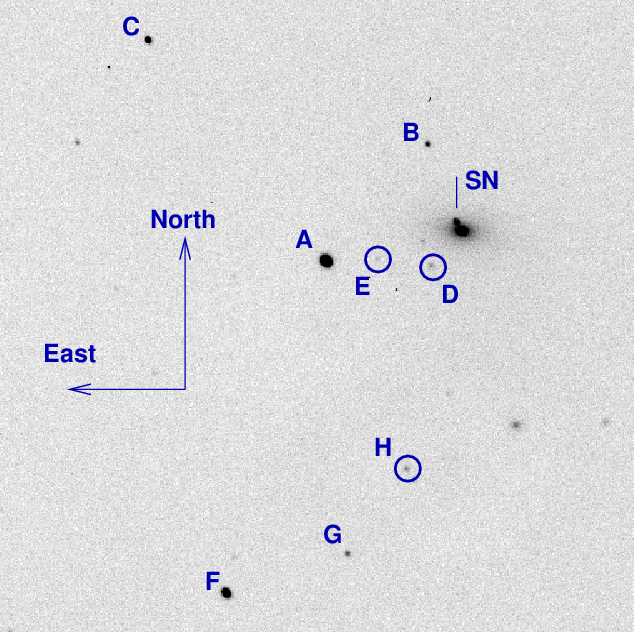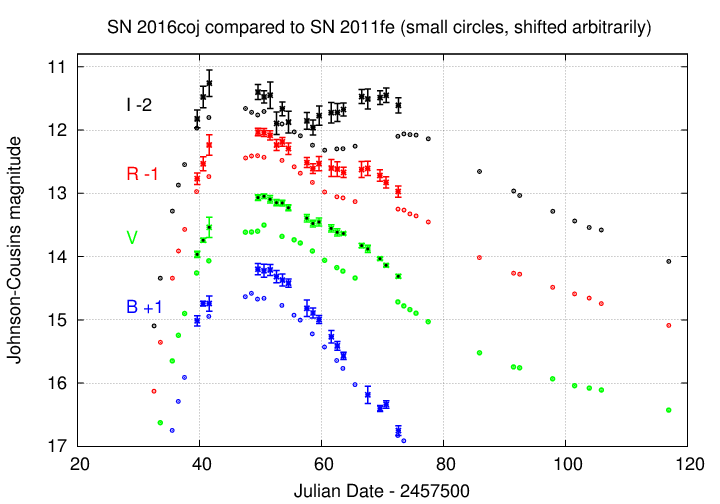
On the night of Jul 02/03, 2016, I observed SN 2016coj in NGC4125.
The main setup was:
Notes from the night
SN 2016coj is a Type Ia supernova in the relatively nearby galaxy NGC4125. It was discovered by the KAIT group some time before maximum light:
NGC 4125 RA = 12:08:05.7 Dec = +65:10:30 (J2000)

The AAVSO sequence team kindly provided photometry for stars near this object. You can see their full photometric sequence on their website. Below, I show only the members of that sequence which fall into my very small field of view -- taken from AAVSO sequence X16266F.
letter B sigB V sigV R sigR I sigI ------------------------------------------------------------------------ B 15.198 0.086 14.133 0.052 13.627 0.116 13.155 0.156 C 13.317 0.093 12.673 0.058 12.316 0.121 11.980 0.161 -------------------------------------------------------------------------
I've been investigating the cause for changes in the values of 30-second dark frames. Tonight's darks were taken with the chip at a constant temperature of about -15 degrees Celsius.

I was careful not to expose the CCD to any levels above 50,000 counts during the flatfielding, but the graph still shows that the dark images taken immediately AFTER the flatfields (set starting at 9:11 PM) have higher values than those taken BEFORE the flats (8:29 PM) or those long after.
So, perhaps even sub-saturation level photon counts can lead to excess charge; or the cause of this effect is something else.
I took sets of 15-20 images in each filter, guiding in BVRI. I used longer guide exposure times (15 and 10 sec) in B and I, respectively. I discarded any trailed images. I checked the focus after RVB on NGC 4125, re-setting for I-band. It helped, as the I-band frames had roughly the same FWHM as V and R.
As explained in the notes to Jun 14, 2016, I used the "rotsub" technique to remove the galaxy's light at the position of the SN.
On this night, I used "method 2", which means performing "rotsub" on each individual image, then combining all the resulting images in a passband to make a "master rotsub" image.
Using aperture photometry with a radius of 4 pixels (radius of 5.5 arcsec) I measured the instrumental magnitudes of a number of reference stars and the target. Following the procedures outlined by Kent Honeycutt's article on inhomogeneous ensemble photometry, I used all stars available in each image to define a reference frame, and measured each star against this frame. I used the interim reference magnitudes above plus color terms which I am currently revising -- so please treat these results as preliminary to convert the ensemble instrumental magnitudes to the standard Johnson-Cousins BVRI scale.
Note that in the graph below, I combine data calibrated with UCAC4 photometry (first few weeks) with recent data calibrated with AAVSO photometry. That's inconsistent, and I'll re-compute all magnitudes later.
filter mag mag_uncert Julian Date
SN B = 15.750 +/- 0.076 (ens 0.057 zp 0.050) 2457572.60777
SN V = 14.312 +/- 0.027 (ens 0.027 zp 0.003) 2457572.59693
SN R = 13.972 +/- 0.089 (ens 0.023 zp 0.086) 2457572.58897
SN I = 13.609 +/- 0.120 (ens 0.030 zp 0.116) 2457572.62019
Below is a preliminary light curve, based on RIT Observatory measurements. I also show measurements of SN 2011fe in M101, an ordinary type Ia supernova, shifted arbitrarily.

Last modified 07/04/2016 by MWR.